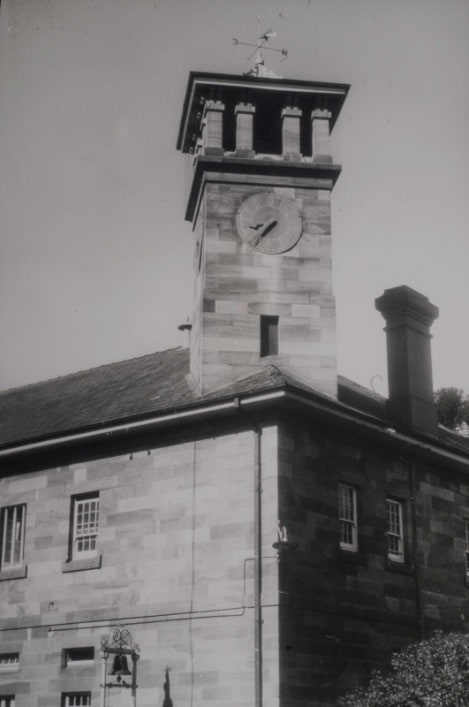
The site of the Former Parramatta Mental Hospital in North Parramatta is located on Fleet Street, where the Cumberland Hospital campus grounds now stand. Approaching the site, we could see the remains of some historically significant landmarks. Around 65 years onwards, we can see the ways that the buildings have been repurposed, reconditioned and preserved throughout the years. Further, remnants of the Female Factory (demolished around 1883) and Asylum, pre-dating the Mental Hospital, are still visible on the grounds. The following images have been selected to show the transition between then and now.

Image 1_ Parramatta Mental Hospital, view of M1 Ward from across the bowling green, ca. 1950. Local Studies Photograph Collection Parramatta Heritage Centre
Featuring the former Airing Yard in front of Male Ward 1 and view of the clock tower and bell. This bowling green was well-known in the day as a lawn bowls rink[1] and used as part of Recreational and Occupational Therapy[2].
The Male Ward 1 building is on the site where the main building of the Female Factory used to be. This building was completed in 1884, the clock tower was originally from the Female Factory main building. In 1885, 675 male and 384 female patients were present[3].
On the inside, the beds of the ward were often lined up in rows under the windows so the sun could shine through the room. There were two rows down each side of the ward with an aisle down the centre[4]. The ward designation was important as patients often identified themselves by gender followed by ward number (such as “C.K., of Male 1”[5]) to share writings such as book reviews and poetry in the hospital publication, Wisteria Journal.
This bell is located in front of Ward 1, beneath the clock tower (visible in Image 2). Fixed to an iron frame, you can imagine it might have been used for alerting patients of meal times or activities. Rules existed for “Ringing of the Bell” by staff as continuous ringing of the bell would indicate an emergency situation[6]

Image 3_Parramatta Psychiatric Centre, view of old emergency bell outside ward 1, ca. early 1980s, Local Studies Photograph Collection Parramatta Heritage Centre LSOP 64
The clock was one of the only remnants kept from the Female Factory and relocated to this present site. The bell is dated 1820, additionally the clock is engraved “Thwaites and Reed, Clerkenwell, London 1821”.[7]

Image 5_Parramatta Psychiatric Centre, view of male ward 1 clocktower, ca. early 1980s, Local Studies Photograph Collection Parramatta Heritage Centre LSOP 67
An anonymous contribution to the Wisteria Journal featuring patient writings included a joke about the clock as follows:
One nice morning a doctor happened to go past the clock tower (Ward Male One) and met a patient from an open ward.
Patient to doctor: “Good morning, doctor. How are you this very good morning, how are you feeling? Could you tell me, doctor (pointing to tower) is that clock right?”
Doctor (after looking at wrist watch): “Yes, yes, she’s all right”.

Image 7_Parramatta Mental Hospital, view of food delivery trucks outside the hospital kitchen, ca. 1950, Local Studies Photograph Collection Parramatta Heritage Centre LSOP 58

Image 8_The former Main Kitchen (Male) building is now vacant. Parramatta Heritage Centre Photo Maribel Morales, 2015
The exhaust vents and chimney can still be seen today. A patient from Male ward 1 publically thanked the cooks in Wisteria Journal, noting that they had prepared an Anzac Day breakfast[8]. It is clear that the cooks were much loved by staff and patients as evident in the condolences offered in the same publication[9]. Meals were cooked in huge vats and then placed in a train of small trucks (as pictured above) so that hot dinner could be brought to the wards[10].Rusticated Fountain.

Image 10_The rusticated fountain at Eastern Circuit. Parramatta Heritage Centre Photo Maribel Morales, 2015
This image shows the rusticated fountain which was once part of the main entrance to the Mental Hospital, now known as Cumberland Hospital. Constructed with mixed materials bound by cement mortar and rubble[11], the style of the fountain has sunk joints and a roughened surface.
![]() Article by Sally Chik and Maribel Morales, Parramatta Council Heritage and Visitor Information Services, 2015
Article by Sally Chik and Maribel Morales, Parramatta Council Heritage and Visitor Information Services, 2015
References
[1] Wisteria Journal: Quarterly Magazine of the Parramatta Mental Hospital. Vol. 1. No 5. July, 1952, p. 25.
[2] Wisteria Journal: Quarterly Magazine of the Parramatta Mental Hospital. Vol. 1. No 3. February 1952, p. 4.
[3] Hidden Heritage: 150 years of Public Mental Health Care at Cumberland Hospital by Terry Smith (1999), Parramatta 1849-1999, p. 19.
[4] Wisteria Journal: Quarterly Magazine of the Parramatta Mental Hospital. Vol. 1. No 3. February, 1952, p. 6.
[5] Wisteria Journal: Quarterly Magazine of the Parramatta Mental Hospital. Vol. 1. No 5. July, 1952, p. 23.
[6] Hidden Heritage: 150 years of Public Mental Health Care at Cumberland Hospital, Parramatta 1849-1999, p. 21.
[7] Hidden Heritage: 150 years of Public Mental Health Care at Cumberland Hospital by Terry Smith (1999), Parramatta 1849-1999, p. 19.
[8] Wisteria Journal: Quarterly Magazine of the Parramatta Mental Hospital. Vol. 1. No 5. July, 1952, p. 11.
[9] Wisteria Journal: Quarterly Magazine of the Parramatta Mental Hospital. Vol. 1. No 5. July, 1952, p. 3.
[10] Wisteria Journal: Quarterly Magazine of the Parramatta Mental Hospital. Vol. 1. No 14. November, 1954, p. 2.
[11] Conservation Management Plan and Archaeological Management Plan: Cumberland Hospital East Campus and Wisteria Gardens by Edward Higginbotham and Associates, Geoffrey Britton and Terry Kass (April 2010), p. 293.





